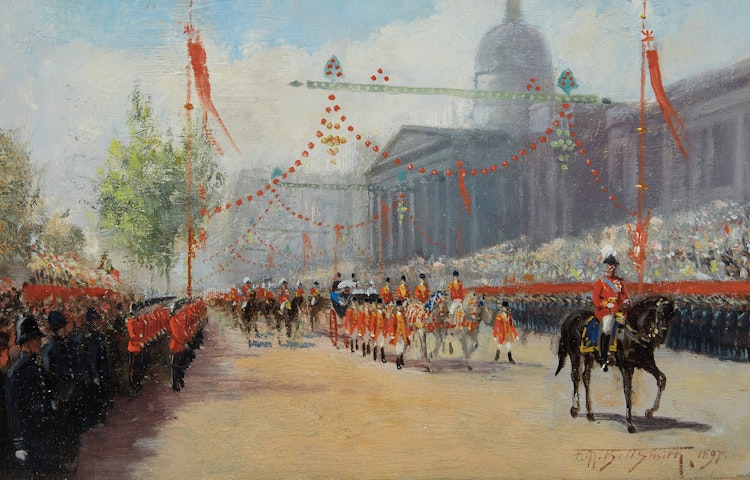Queen Victoria’s Jubilee Procession by Frederic Marlett Bell-Smith

F.M. Bell-Smith
Queen Victoria’s Jubilee Procession
oil on board
signed and dated 1897 lower right; inscribed “Queen Victoria’s Jubilee Procession passing the National Gallery, London, June 22nd, 1897” on the reverse
6 x 9 ins ( 15.2 x 22.9 cms ) ( sight )
Auction Estimate: $5,000.00 - $7,000.00
Price Realized $4,400.00
Sale date: November 22nd 2021
Private Collection, Toronto
Roger Boulet, “Frederic Marlett Bell-Smith (1846-1923)”, Art Gallery of Greater Victoria, Victoria, 1977, pages 80-81 for similar compositions
Bell-Smith was employed as a freelance illustrator by various publications, including the “Canadian Illustrated News”. The artist was commissioned to visit London for the Jubilee celebrations. He made notes on the passing pageantry and took photographs as a frame of reference during the actual execution of the final paintings. Bell-Smith applied his academic training and traditional artistic style in the various works of this significant event that he produced and included a watercolour in the Nineteenth Exhibition of the Royal Canadian Academy in 1898.
Share this item with your friends
Frederic Marlett Bell-Smith
(1846 - 1923) OSA RCA
Frederic Marlett Bell-Smith (1846-1923) was born in London, England and died in Toronto, Ontario. His earliest training was under his artist father. He attended the South Kensington School of Art under Alexander Hamilton until his family emigrated to Montreal, Quebec in 1867. Later, he studied in Paris at the Academie Colarossi under Joseph-Paul Blanc, Gustave Courtois, and Edmond-Louis Dupain. The artist arrived in London, Ontario in 1881 where he was appointed Art Director of Alma College (St.Thomas) and, the following year, Drawing Master at Central Public School. In 1888 he moved to Toronto where he was named principal of the western branch of the Toronto Art School. He continued to serve at Alma College until 1901. Bell-Smith was a founding member of the Society of Canadian Artists, the Ontario Society of Artists, and the Western Art League. He was elected an Academician in the Royal Canadian Academy and played important roles in many local and national artistic associations. His work was very popular in his lifetime: he painted portrait, genre, and landscape subjects in both oil and watercolour in the impressionistic, picturesque, and sublime styles of the last century. Bell-Smith also won many international honors in his career.

